Are you missing out on significant sales? WooCommerce’s usual pricing might cause you to lose customers. If so, WooCommerce tiered pricing can make a big difference for your store.
A WooCommerce tiered pricing strategy can be provided to people who buy more of your products. This would encourage them to buy more and increase your average sales.
Setting up a Woocommerce tiered pricing structure helps clear out stagnant stock and encourages customers to purchase more by offering discounts based on quantity.
In this blog post, you’ll learn the process of setting up tiered pricing for WooCommerce sites and explore some essential tips for maximizing the effectiveness of this strategy.
Despite WooCommerce overlooking this feature, tiered pricing can be easily implemented using plugins like “Discount Rules for WooCommerce -Pro.”
Let’s dive into how you can leverage this powerful tool to drive sales and optimize your product discounts.
What is WooCommerce Tiered Pricing?
WooCommerce tiered (or) volume pricing allows you to set different prices for a product based on the quantity purchased. In simpler terms, customers get a discount for buying more of the same item.
Here’s how this tiered pricing strategy works:
- You define different quantity ranges (tiers).
- Each tier has a specific price per unit.
- The price per unit decreases as the quantity purchased increases.
A Simple Example of Tier Pricing Structure
Imagine you have refreshing Mango juice priced at $16. Tiered pricing structures can entice customers to buy larger quantities at a discounted rate, offering them more value for their money.
| Buy 1 Mango Juice | $16 |
| Buy 2-3 Mango Juices | $2 Fixed Discount on Each Unit |
| Buy 4-5 Mango Juices | $4 Fixed Discount on Each Unit |
| Buy 6 or more | $6 Fixed Discount on Each Unit |
So, when a customer buys three mango juices, he can buy each unit for $14, which helps him save $6 on this order. This enhances his shopping experience and increases the average order value.
Create customized tiered pricing using the Discount Rules Pro plugin to boost Average Order Value.
Benefits of Offering WooCommerce Tiered Pricing
Offering tiered discounts benefits you in many ways:
- Increase Average Order Value: Tier pricing discounts encourage customers to add more to their cart than they originally intended to purchase, which increases your average order value.
- Boost Sales and Revenue: WooCommerce tiered pricing helps customers to stock their favorite products in bulk with huge savings, which increases your sales and revenue.
- Enhance Customer Loyalty: Customers who buy specific products frequently in bulk can enjoy this tier pricing, as they can get discounts when buying large quantities. This enhances customer experience and retains them for future purchases, elevating customer loyalty.
- Become a Wholesale Distributor: Tier pricing in WooCommerce is an effective tactic to attract wholesale customers who are buying bulk products for their stores. Due to effective tier pricing, they can easily become your regular customers in order to save money.
- Increase Brand Reach: WooCommerce tiered discounts can help you attract new customers who are looking for the best deals on bulk purchases.
- Competitive Advantage: Offering WooCommerce tiered pricing can make your products more attractive to price-sensitive customers, giving you a competitive edge over businesses that don’t offer similar discounts.
When Should You Offer Tiered Pricing In WooCommerce?
Implementing tiered pricing can significantly enhance sales, yet timing is critical to maximize its effectiveness.
- Selling Bulk Products: Suppose you are selling products that are often purchased in large quantities, such as cosmetics, skincare, beverages, and household or office supplies. In that case, multi-tier pricing urges them to buy more, which boosts sales and revenue.
- Increasing Wholesale Customers: Tier-structured pricing can be offered for wholesale customers who buy in bulk for resale. Offering discounts to these specific customer groups can establish a long-term relationship and increase sales.
- Clearing Inventory: If you have excessive old stocks or slow-moving products, offer discounts with layered pricing to clear these products and refill your inventory with fresh stocks.
- Product Subscription Services: WooCommerce tiered pricing can also be useful if you offer product subscriptions. Offering different discounts and deals based on each subscription stage can help you increase revenue.
- Holiday Sales: Offer tiered discounts on holiday gift sets or seasonal products to encourage larger purchases.
- End-of-Season Clearance: Following tiered pricing strategy and implementing deep discounts on remaining inventory to clear stock and make room for new collections.
- Early Bird Discounts: Give early customers special discounts to create excitement and encourage more sales.
How To Setup WooCommerce Tiered Pricing?
Setting WooCommerce tiered pricing for products is quite simple. You only need the “Discount Rules for WooCommerce—Pro” plugin to create your price structure.
This plugin enables tiered discounts in WooCommerce, allowing you to set flexible rules for discounts, such as specific prices or percentages based on purchased product quantities.
Easily establish pricing tiers across your store to implement a powerful, quantity-based pricing strategy.
Create tiered pricing for specific wholesale customers using the Discount Rules plugin and enhance customer experience & loyalty.
Before creating the tiered pricing, make sure to install and activate the Discount Rules plugin on your WordPress dashboard.
We will discuss different scenarios for creating tiered pricing for WooCommerce stores.
Scenario 1: WooCommerce Tiered Pricing for a Specific Product
Example: To boost sales, let’s create a fixed pricing structure for mango juice, a specific product.
To create WooCommerce tiered pricing for a specific product:
- Go to “WooCommerce” -> “Discount Rules”.
- Add a new rule and select “Discount Type” as “Bulk Discount.”
- Filter the specific product to provide quantity tiers.
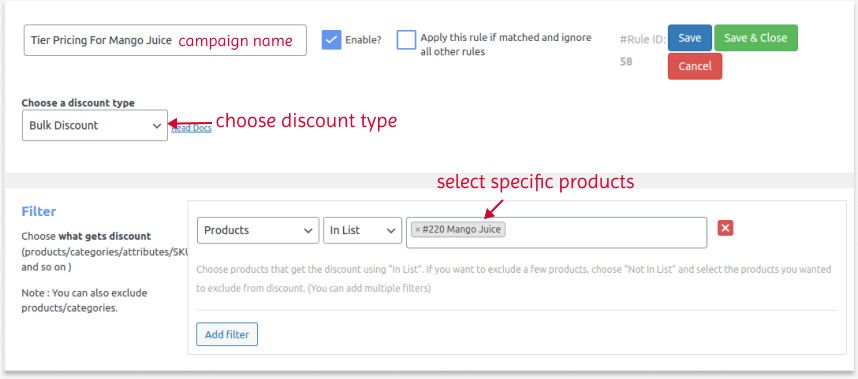
- In the “Discount” section, set “Minimum & Maximum” buying quantities and discounts. Choose “Fixed Discount” and set values for each quantity.
- Save and enable the rule.
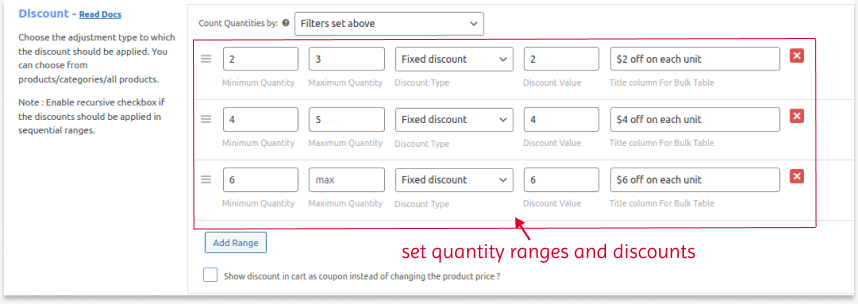
Multi-level pricing is applied to the product, and customers can get discounts based on quantities.
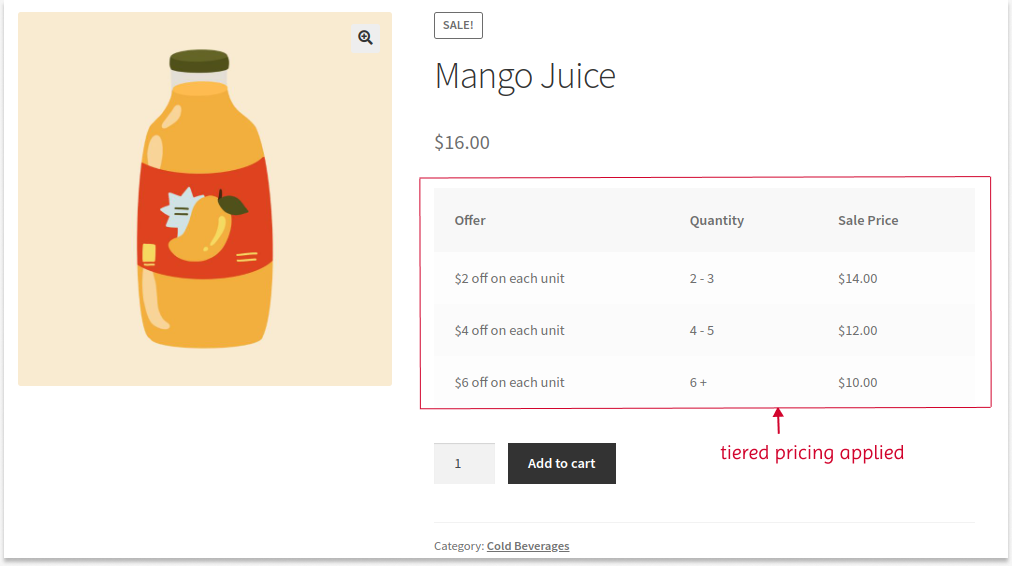

Scenario 2: WooCommerce Tiered Pricing Based On Specific Customer Roles
Example: Let’s offer tiered pricing only for wholesale customers. We can apply a store-wide discount with a fixed cost per unit.
To create a tiered pricing based on specific user roles:
- Navigate to “WooCommerce” -> “Discount Rules”.
- Select the discount type as “Bulk discount.”
- Since it is a storewide discount, filter “All Products.”
- In the “Discount” section, set buying quantities. Choose “discount type” as “Fixed price for item” and set value.
- In the “Rules” section, select “Condition Type” as “User Role” and select a specific customer role as “Wholesale Dealers”.
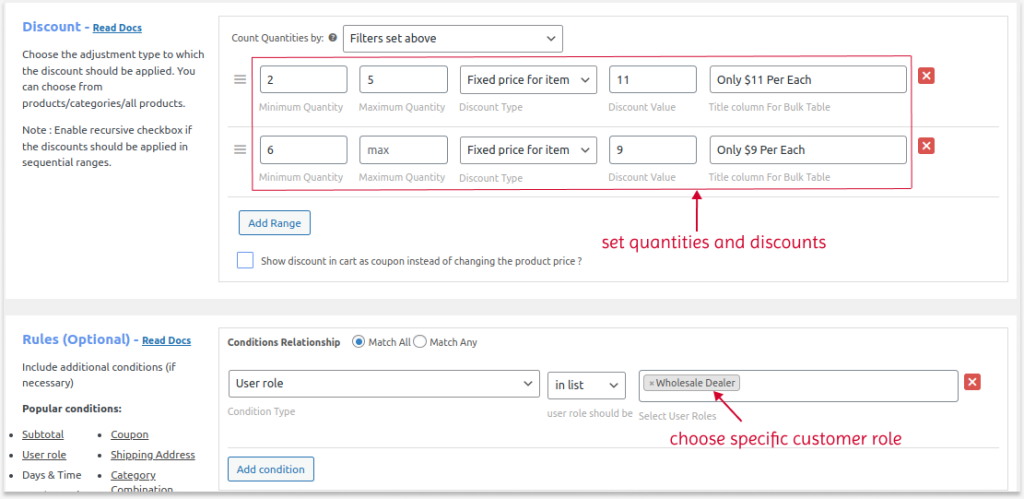
When wholesale customers log in to the store and buy products, a fixed price will apply based on quantities.
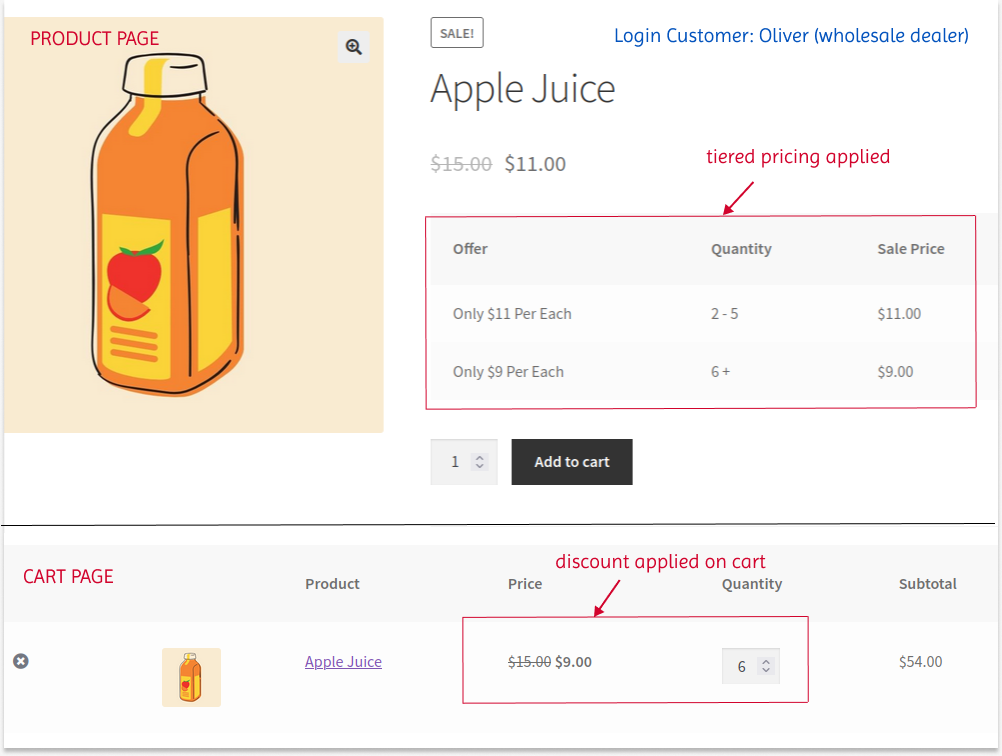
Related Read:
How to Create WooCommerce Coupons for Specific Users and Roles?
Scenario 3: Tier Structure For Variable Products
Variable products provide a single product with multiple variations, and we can offer tiered discounts to these variable products.
Example: We can set tier pricing for a specific variable product with a percentage discount and few purchase conditions.
To apply WooCommerce tiered pricing for variable products:
- Go to the “WooCommerce” dashboard and open “Discount Rules”.
- Select the “Bulk Discount” type.
- Filter the specific “Variable product”. For example, “Women’s Cardigan”.
- Set buying quantities and choose the “Percentage Discount” type to set value.
- Also, select “Count Quantities By” as “Individual product”. This option counts each product quantity individually without taking all product quantities.
- For example, consider two products, A (3 quantities) and B (6 quantities), with a 5% discount for 1 to 3 quantities, 10% for 4 to 6, and 12% for more than six quantities.
- If you select the “Individual Product” option, 5% will be applied to product ‘A’ and 10% to product’ B.’
- However, if you set “Count Quantities By” as “Filters Set Above,” it will take the total quantities as 9 (both A & B) and apply a 12% discount.
- Select the option based on your sales goal.
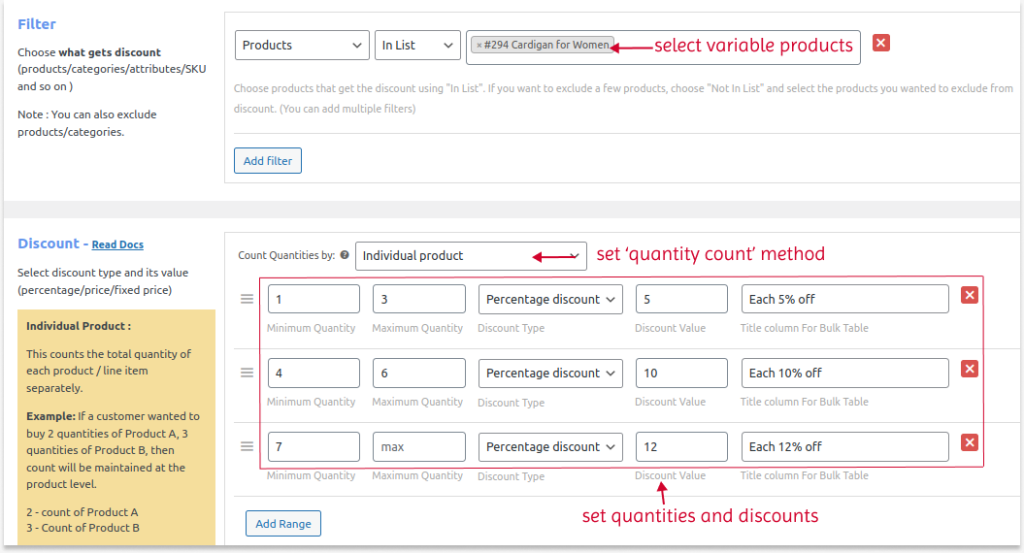
- Optionally, in the “Rules” section, select the condition “Attributes” and select some attributes, such as color. Customers should add any of these attributes to their cart to get tiered discounts.
- You can also set the expiry date for this rule. The rule discount will be invalid after the expiry date.
- Save the rule.
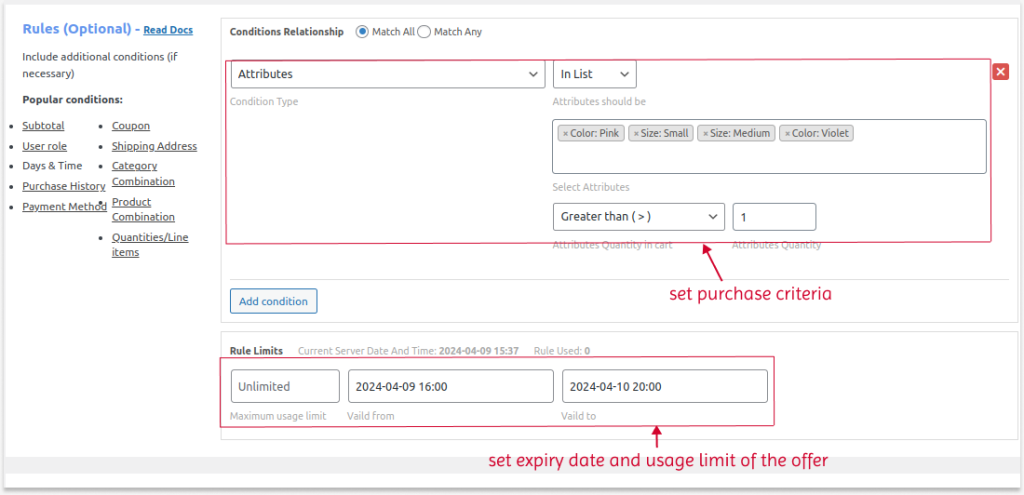
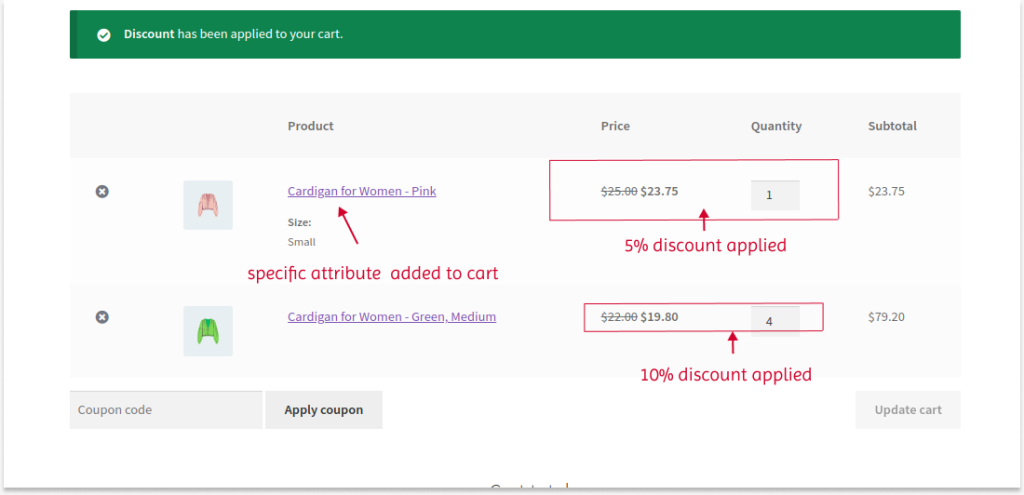
Related Read:
How to create percentage discounts in WooCommerce?
Similarly, you can create tiered pricing for specific categories and set specific purchase criteria in the “Rules” section, such as cart total, number of orders made, specific users, or payment method.
You can even create WooCommerce coupons for volume pricing by selecting “Coupons” as a condition and setting your coupon code. Customers have to enter this code at checkout to get tiered discounts.
How To Customize Tiered Pricing Table In WooCommerce?
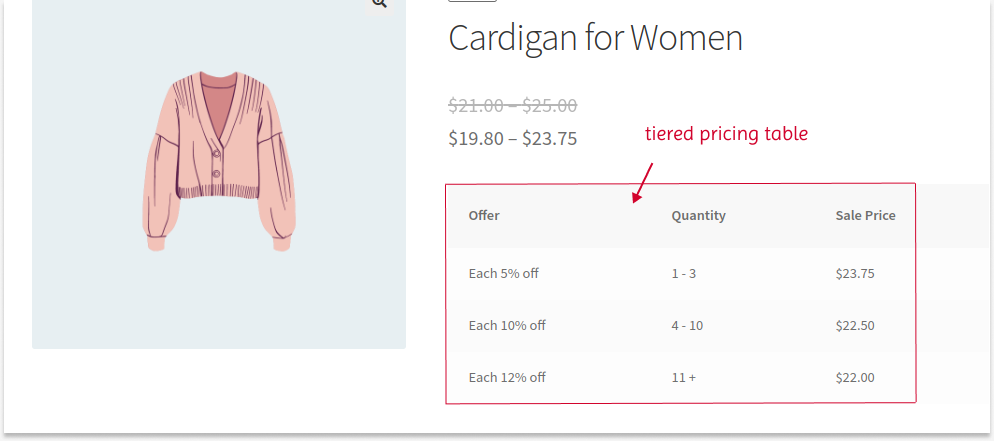
The “Discount Rules” plugin also provides customization options to add WooCommerce tiered pricing table and customize it.
To do that:
- Go to the “Discount Rules” settings page.
- Scroll down to the product section. You can find the “Show Discount Table” option.
- Click “Yes” and select “Customize Discount Table”.
- A popup will display features to customize the discount table’s contents, such as the table header, title column name, discount column name and value, and range column.
- Customize these features based on your preferences and click “save”.
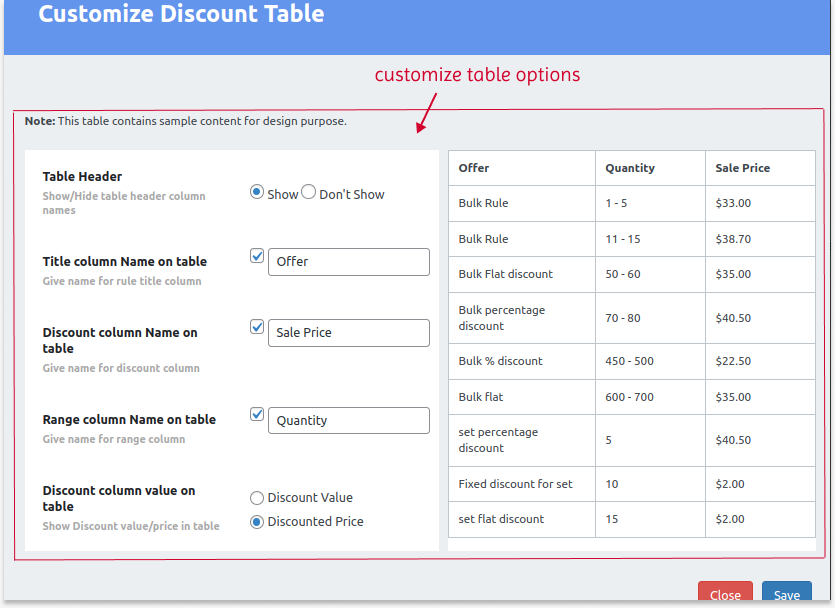
Below this is the “Position to show discount table” option, which can change its display positions on product pages.
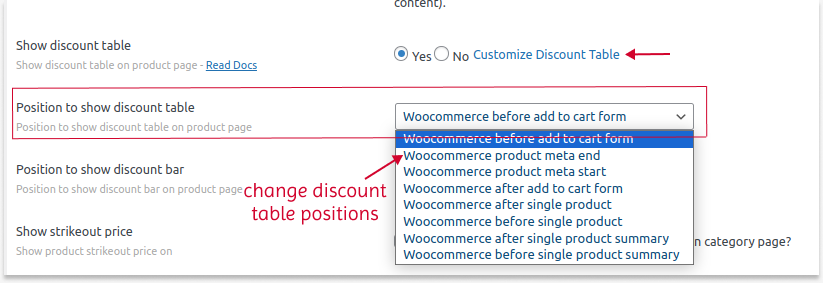
Which Businesses Can Implement WooCommerce Tiered Pricing?
Tiered pricing is a must-try strategy for all store owners to get bulk orders, yet the following business fields can get more profits:
- High-Volume & Wholesale Businesses: Offer tiered discounts based on purchase quantity. The bronze tier is for small orders, Silver for medium, and Gold for bulk purchases with the highest discount.
- Businesses with Product Variations: Create tiers based on product variations. For example, clothing stores could offer lower prices for single items, a discount for buying a set (shirt & pants), and an even steeper discount for buying the entire outfit (shirt, pants, & shoes).
- Businesses with Premium Products: Offer a base tier with essential products and higher tiers that unlock exclusive, premium items or limited-edition bundles at a discounted price compared to buying them individually.
- Subscription-Based Businesses: Offer different subscription tiers with varying features or support levels. Provide discounts for longer subscription terms, such as quarterly or annual plans.
- Digital Product Businesses: Create bundles of related digital products (e.g., eBooks, courses, templates) and set WooCommerce tiered pricing for purchasing multiple bundles. Offer tiered access to premium content or features, with higher tiers to unlock more exclusive content.
Best Practices in Offering WooCommerce Tiered Pricing Discounts
Following best practices for tier pricing will help you reduce risks, enhance customer experience, and boost sales. Here are some best practices to consider when offering products in quantity tiers:
- Segment Products: You can filter specific products or product categories that are eligible for tiered pricing, making it easy to apply tier discounts.
- Set Clear thresholds: Clearly define the pricing of each tier with specific thresholds to help customers easily understand your pricing structure.
- Personalize discounts: When offering discounts in tiers, personalize them to match customer preferences. This helps you capture target customers.
- Customer Feedback: Get feedback about your pricing structure from verified customers to analyze whether it is effective for them.
- Monitor Inventory and Sales: Frequently monitor inventory and adjust prices based on your stock level. Monitoring sales and updating pricing based on the campaign outputs is also essential.
- A/B Testing: Experiment with different tiered pricing strategies to see what works best for your specific audience and products.
- Customer Segmentation: Segment your customers based on their purchasing behavior, demographics, or other relevant factors. Offer personalized tiered pricing to different segments to increase customer satisfaction and loyalty.
Offer conditional-based tiered pricing for specific products or categories using the Discount Rules plugin and increase sales.
Conclusion
Customers are looking for good deals when purchasing products in large quantities. Offering tiered pricing that matches customer preferences can acquire more customers and increase sales.
With the right WooCommerce tiered pricing plugin, like “Discount Rules for WooCommerce—Pro,” you can personalize your discounts and customize tiered pricing for specific products and customers. You must strategically plan pricing to increase your average order value.
Also Read:
- How to create bulk discounts in WooCommerce?
- Detailed steps to set up quantity discounts in WooCommerce.
- How to create bundle discounts in WooCommerce?
Wholesale-tiered discount or tiered pricing is a strategy where different price levels are set based on the number of products purchased. It offers lower prices for larger quantities, incentivizing bulk purchases and appealing to wholesale buyers.
Tiered pricing in ecommerce is a strategy where different prices are set for different levels of product quantities. It encourages customers to buy more by offering a lower price per unit when they purchase larger quantities. This method can help increase sales volume and customer loyalty by providing more value to those who buy in bulk.
For example, a product might have a standard price, but if a customer buys a certain quantity (a tier), they receive a discount for each item in that tier. This incentive to purchase more items at once- benefits both the customer and the seller.
A two-tiered pricing structure involves offering two distinct price levels for a product, usually targeting different customer segments. The first tier might offer basic features at a lower price, while the second tier offers enhanced features or benefits at a higher price. This strategy allows businesses to cater to varying customer needs and budget ranges.
Three-tier pricing is a strategy where a product is offered at three different price points, each with varying features or benefits. This allows customers to choose based on their needs and budget, catering to different segments of the market.
To create a price tier, follow these general steps:
1. Identify the different quantity levels or customer segments you want to target with your pricing tiers.
2. Determine the pricing structure for each tier, including the base price and any discounts or adjustments based on quantity purchased or customer type.
3. Implement the pricing tiers in your sales funnel.
4. Clearly communicate the pricing tiers to your customers through your website, marketing materials, or sales channels.
5. Monitor and analyze the effectiveness of your pricing tiers over time, making adjustments as needed to optimize sales and profitability.
Several types of businesses can be significantly affected by tiered pricing, including:
1. Wholesalers and Distributors: Incentivize bulk orders with tiered pricing.
2. Software as a Service (SaaS) Companies: Offer tier pricing structure based on features or user levels.
3. Subscription-Based Services: Vary pricing tiers for different levels of access.
4. Manufacturers and Suppliers: Use volume-based discounts to offer discounts on larger orders.
5. E-commerce & WooCommerce Retailers: Encourage larger purchases with tiered discounts.
Price discrimination refers to charging customers different prices for the same product or service based on factors such as willingness to pay, demographics, or purchase behavior.
In tiered pricing, customers are segmented into different groups based on factors like quantity purchased, usage level, or desired features, and each group is offered a different price.
This allows businesses to capture additional revenue from customers willing to pay more while offering lower prices to price-sensitive customers.
Quantity-based pricing can be a legitimate pricing strategy to better serve customers’ varying needs and preferences as long as it is implemented transparently and fairly.
While tiered pricing can offer several benefits, it also has some potential disadvantages, including:
1. Complexity: Managing multiple tiers complicates pricing structures.
2. Customer Confusion: Numerous options may confuse customers.
3. Perceived Unfairness: Some may view layered pricing as unjust.
4. Risk of Cannibalization: Lower tiers may undercut higher ones.
5. Administrative Burden: Maintaining tiers requires ongoing attention.
6. Segmentation Errors: Misidentifying segments can lead to missed opportunities.
7. Competitive Pressure: Rivals’ simpler pricing may pose challenges.
Businesses should thoughtfully consider and implement tiered pricing to maximize revenue while addressing diverse customer needs.
Tiered pricing in SaaS or subscription-based businesses can vary based on the number of users, offering different levels of access for each tier.
However, tiered pricing isn’t limited to user count and can also be influenced by factors like usage, features, or discount levels, depending on the business’s segmentation strategy.
The main difference between tiered and flat pricing lies in how prices are structured:
1. Tiered Pricing:
In tiered pricing, prices are set at different levels (or tiers) based on certain criteria, such as quantity purchased, usage levels, or features included.
Customers pay different prices depending on which tier they fall into. For example, a product might have one price for purchasing 1-10 units, a lower price for purchasing 11-20 units, and so on.
2. Flat Pricing:
Flat pricing has a single, uniform price for all customers regardless of the quantity purchased, usage levels, or other factors.
Everyone pays the same price for the product. This pricing structure is simpler and easier to understand, but it may not cater as effectively to customers with varying needs or budgets.
Tiered pricing in WooCommerce sets different price levels for specific quantity ranges or multiple prices per product. For example, selling 1-5 units of a particular item at $10 and 6-10 units of the same item at $8 can be considered WooCommerce tiered pricing.
Volume pricing, on the other hand involves offering discounts based n the quantity purchased , where the more items you buy, the higher the discount per item.
Tier 1 pricing in WooCommerce refers to the first price level in a tiered pricing structure. It is the base price before any discounts for larger quantities are applied.




